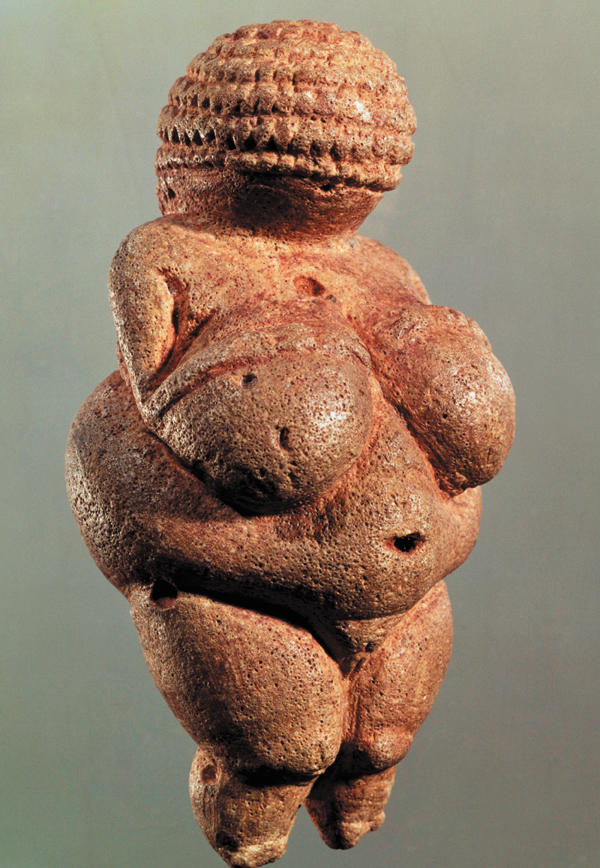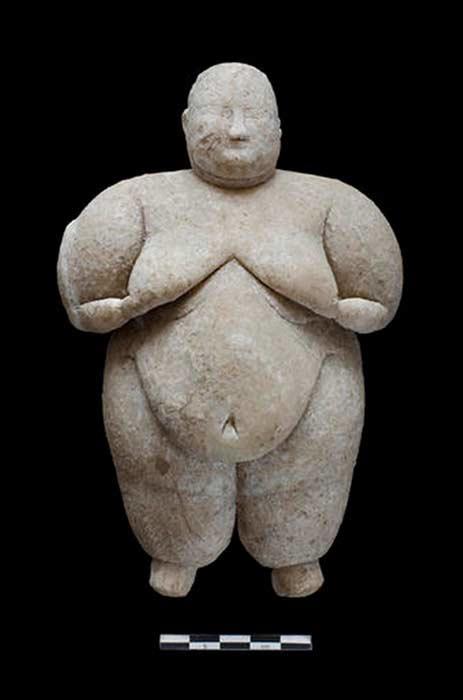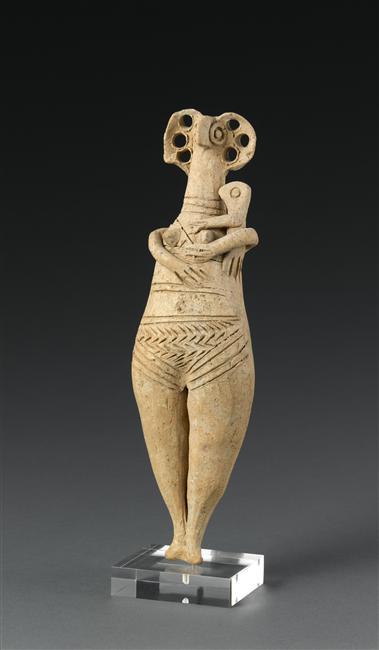Paleolithic

- Title: Nude woman (Venus of Willendorf)
- Location: Naturalhistorisches Museum, Vienna
- Place of origin: Willendorf, Austria
- Materials: limestone
- A website where you found the picture and the information about the image: https://klimtlover.wordpress.com/art-before-history/paleolithic-art/
- Time period of origin: ca. 28,000-25,000 BCE.
Physical properties (lines, shapes, colors, textures): The sculpture is 4 ¼ inches high. The soft curves repeat the natural lines of the female body. The shape is not common and is probably a result of the initial shape of the stone that became material for this sculpture. It is orange-brown, the natural color of the stone.
Analysis of the formal structure: The figure depicts a plump body of a woman. The author probably did not intend to depict reality. A more probable suggestion is that the sculptor could refer to an aesthetic ideal of that time or religious symbolism. The selection of a female figure with a big belly and breasts was probably aimed to represent human fertility similarly to the earlier depictions of animals.
The natural subject: The exaggerated anatomic details provide a supposition that the sculpture could serve as a fertility symbol.
What is the cultural context of the work? What do the images tell you about the culture and the people who created them? Found in Austria, the figure probably represents the first existing school of art. The fact that this sculpture is carved of limestone and not made of clay witnesses craftsmanship of that period. The specific feminine figure focuses on the importance of the child-bearing ability of women for Paleolithic people. This ability provided the survival of Neanderthals. Finally, the small size of the sculpture contributes to the version of its symbolic use and significance. It means that people could easily carry it with them in case of necessity.
Example 2: Neolithic

- Title: Female figurine
- Location: not indicated
- Place of origin: Çatalhöyük, Turkey
- Materials: limestone
- A website where you found the picture and the information about the image: https://arstechnica.com/science/2016/09/amazing-intact-statue-of-a-woman-unearthed-at-the-neolithic-city-of-catalhoyuk-in-turkey/
- The period of origin: 6300-6000 BCE
Physical properties (lines, shapes, colors, textures): The figurine is carved from limestone. It has soft round lines and rounded shapes. The figurine is of natural limestone color. The texture is smooth. It is 17 cm high.
Analysis of the formal structure: The shape of the figurine does not have signs of a young body or pregnancy. It contributes to the idea that the sculpture can represent an older prosperous woman with a certain position in society.
The natural subject: Figures of goddesses are traditionally related to fertility.
What is the cultural context of the work? What do the images tell you about the culture and the people who created them? There is a possibility that the figurine does not symbolize a goddess of fertility but an adult woman who had some influence in the society of that time. It is supposed that at the time the figurine was created, the society was transitioning to a stratified system with a certain hierarchy from egalitarian origins. This figurine is different from the previous sculptures due to the craftsmanship. Moreover, the figurine was found in the position that could have some ritual meaning. Also, the proportions of the sculpture prove that the artists of that time had good knowledge of the human body.
Example 3: Bronze OR Iron Age

- Title: Female and child figurine
- Location: Louver, Paris
- Place of origin: Tyre, Lebanon
- Materials: clay
- A website where you found the picture and the information about the image: https://www.photo.rmn.fr/CS.aspx?VP3=SearchResult&IID=2C6NU0KNMAHN&PN=1&LANGSWI=1&LANG=English
- The period of origin: 1500-1200 BCE
Physical properties (lines, shapes, colors, textures): The sculpture is 24 cm high and 6.8 cm long. Its lines are curvy and soft. It is beige, the natural color of clay. The surface is smooth with some ornaments. There are three perforations in every ear.
Analysis of the formal structure: The rounded hips of the sculpture and a baby in her hands probably were used by the sculptor to attract attention to the significance of maternity.
The natural subject: The sculpture, similarly to female figures of previous ages, symbolizes fertility. The presence of a child in her hands is a symbol of the maternity ward.
What is the cultural context of the work? What do the images tell you about the culture and the people who created them? The sculpture is a proof of the symbolic character that maternity has at the period it was created. The use of clay for the sculpture was traditional. However, the fact that the sculpture is hollow inside speaks about the improved skills of sculptors. The depiction is rather schematic which is typical for that period. The pierced ears of the figure refer to the Asiatic type.
References
Ancient to Medieval art. (n.d.). Web.
Figurine: Femme nue tenant un enfant. (n.d.). Web.
Newitz, A. (2016). Incredible discovery of intact female figurine from Neolithic era in Turkey. Web.